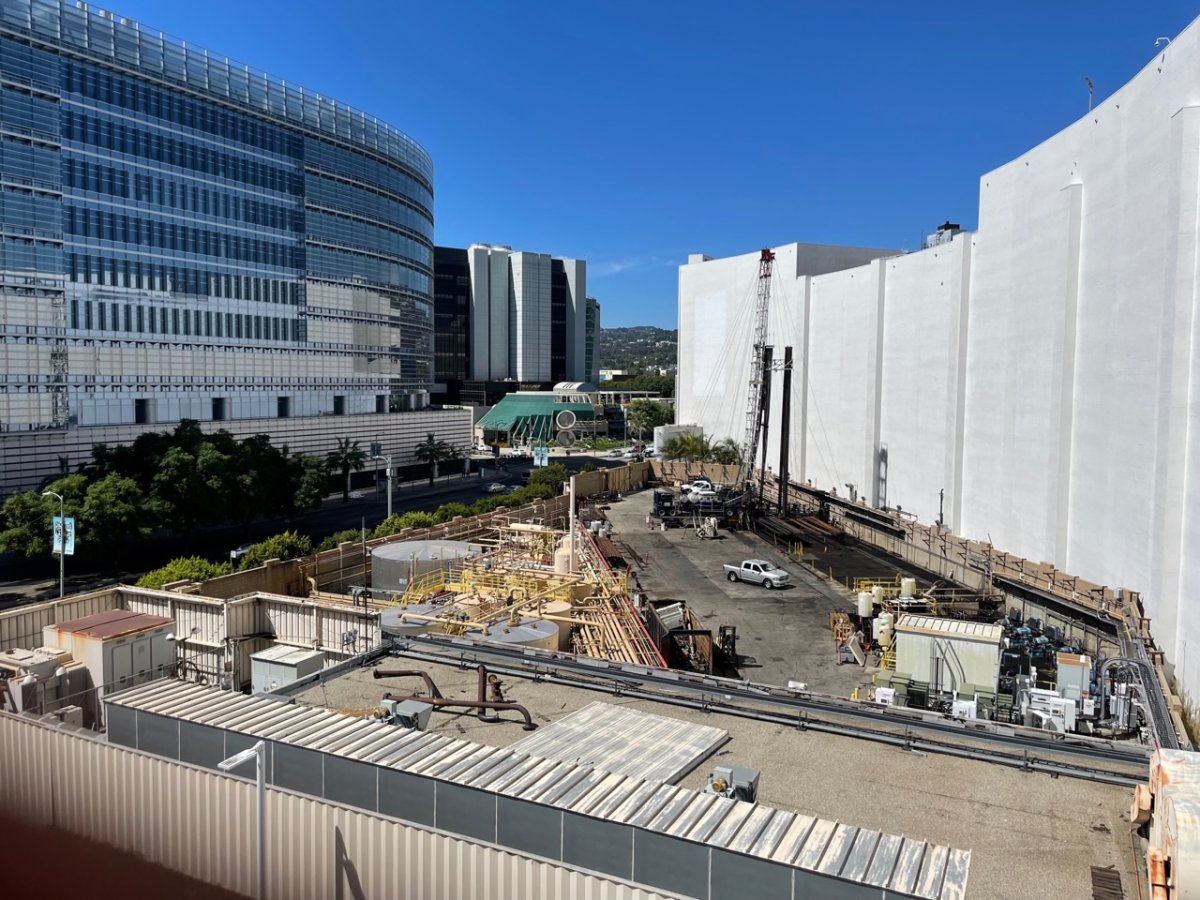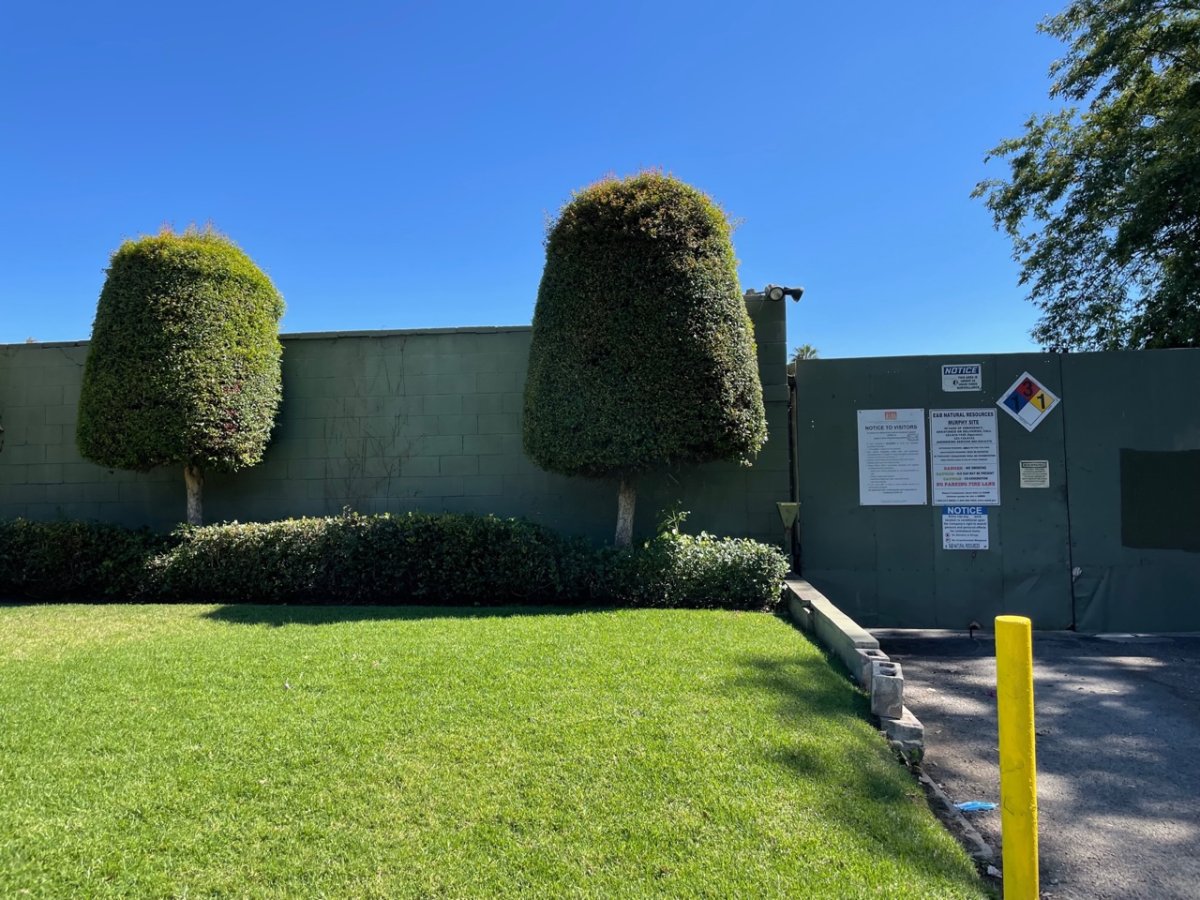Phasing Out Oil Wells Close To Our California Communities Has Nothing To Do With Gas Prices and Everything To Do With Public Health
For many years I didn’t know that I lived near so many oil wells in my dense Los Angeles neighborhood. That office building about ¼ mile from me? It’s a façade for a recently closed oil and gas extraction site. The building that looks like a synagogue? No one goes there to pray. It’s a front for another inactive oil well.

Cardiff Oil Tower with school crossing sign
A wall next to the Beverly Center Mall and across from Cedar Sinai Hospital hides a big, active oil drilling site. In the historic Adams area of LA, the Murphy Oil site operates behind a wall next to a clinic for deaf children, a convalescent home, and residential buildings. That flower-power painted structure at Beverly Hills High School hid a system of oil wells. Once abandoned, the wells were left to be plugged by the city.

Beverly Center oil drilling site
In 1892, when Charles Canfield and Edward Doheny dug the first oil well in Echo Park, Los Angeles was a small town sitting on a big lake of oil. At that time, it was possible to keep some distance between the oil-producing zones and residential areas. Now, about half a million Angelenos, from Wilmington, to Echo Park, to Downtown LA, to the Westside, spend their daily lives less than a ¼ mile from an unplugged oil well. Some of these oil wells operate with broken cement seals and poorly maintained pipelines. Many are abandoned and left unplugged.

Early oil pump (Placerita Canyon)
Why does this matter? Because people living near oil wells complain about serious health problems. Their health concerns are backed up by a scientific panel that reported to the California Geologic Energy Management Division (CalGEM) in 2021, a 2019 National Institute of Health (NIH) study, The Center For Biological Diversity (2017), and a steady drumbeat of studies from universities such as Yale, Stanford, and USC.
These studies document the long-term health consequences of living near oil drilling sites. Besides the noise, oozing sludge, and odor, chemical gasses such as benzene, hydrosulphide, and methane are leaked into the air, causing wheezing, asthma, and generally reduced lung function. People suffer from frequent headaches, nausea, nosebleeds, and rashes. High-risk births as well as various cancers have also been connected to living and working near oil wells.
This brings me to the very sensible California Senate Bill 1137 which was signed into law in September 2022, following similar ordinances passed by local governments. If you care for your health and the health of the community, you would support SB 1137. It does not stop oil drilling in California but it does mandate Health Protection Zones (HPZs), 3200-foot buffer zones, where no new oil wells can be dug too close to your homes, schools, hospitals, and shopping areas. The wells that are already there can remain within the 3200-foot buffer zone, but the operators have to make sure that the oil wells are working safely and that they, not the taxpayer, will be responsible for plugging the wells when abandoned.

Murphy oil drilling site in Jefferson Park sits not far from homes...

An elder care hospital...

And clinic for deaf children.
Will SB 1137 affect gas prices? No, it will not! California crude oil prices are tied to global oil prices and events. Because California only produces 29% of its oil, with its wells getting old and producing less, we are dependent on oil from other states and countries. Since this crude oil has to go through refineries first, the price of gasoline depends on the refineries as well. Gasoline costs more to refine in California than in other states. Fewer refineries, aging infrastructure, refinery outages, and higher demand last year caused a supply problem that forced us to pay way more at the pump.
However, SB 1137 was put on hold by a well-funded campaign called Stop The Energy Shutdown which, by December 2022, had collected enough signatures to put a referendum on the 2024 ballot to void this law. Stop The Energy Shutdown is funded by the California Independent Petroleum Association (CIPA), its top donors being major oil extraction companies. They have tried to connect SB 1137 to higher gas prices, said we will lose jobs, and disputed the health findings of various reputable studies, using their considerable funds and scare tactics to get needed signatures to put the initiative on the ballot.

Packard oil site next to residence
As I walk past that fake office building near my home, I realize that California cannot do without oil and gas right away, not until we can develop other sources of cleaner and more affordable energy. But common sense health and safety measures and the availability of affordable oil are not incompatible. These measures are good for the health of all Californians.
Blog Category:



Comments
David Goldstein (not verified)
July 13, 2023 - 10:25am
Permalink
Removing abandoned plugged oil wells
Add new comment